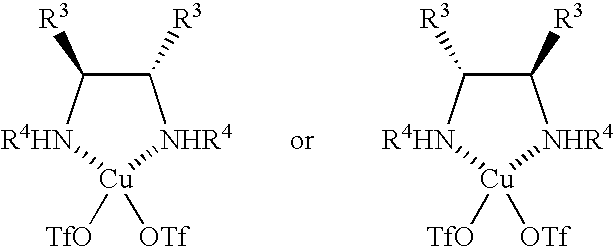Production method for aminophosphonic acid derivatives
a production method and aminophosphonic acid technology, applied in the direction of organic compounds/hydrides/coordination complex catalysts, organic compounds/chemical process catalysts, organic compounds/chemical complex catalysts, etc., can solve the problem that the synthetic method for producing optically active -aminophosphonic acid derivatives has not yet been established, and achieve excellent chemical and asymmetric yield
- Summary
- Abstract
- Description
- Claims
- Application Information
AI Technical Summary
Benefits of technology
Problems solved by technology
Method used
Image
Examples
production example 1
Preparation of an Iminophosphonic Acid Diester Solution
[0039] Piperidinomethyl polystyrene (3.7 mmoles / g, 2,243 mg, 0.9 mmole) and molecular sieve 4A (30 mg) were added to a methylene chloride (3.0 ml) solution of diethyl bromo-(2,2,2-trichloroethoxycarbonyl amino) methylphosphonate (0.3 mmole). The reaction solution was agitated for 20 minutes at room temperature, filtered using a membrane filter (Whatman 0. 15 μm) and the filtrate was used in a reaction without any further treatment.
example 1
Silyl Enol Ether Addition Reaction on an Iminophosphonic Acid Diester Using a Chiral Copper Catalyst in the Co-presence of HFIP
[0040] Methylene chloride (1.5 ml) was added to copper triflate (20 μmoles) and a chiral diamine (22 μmoles), and the reaction mixture was agitated for 6 hours at room temperature. Molecular sieve 3A (10 mg) was added, and the reaction mixture was subsequently cooled to 0° C. A methylene chloride (0.5 ml) solution of the nucleophilic agent (a silyl enol ether, 0.1 mmole) shown in Table 2 and a methylene chloride (0.5 ml) solution of HFIP (0.4 mmole) were added. A methylene chloride (0.1 M, 2 ml) solution of the N-protected-α-iminophosphonic acid diester obtained in Production Example 1 and a methylene chloride (2 ml) solution of a silyl enol ether (0.2 mmole) again were slowly (ordinarily over eight hours) added dropwise. The reaction mixture was agitated for an additional hour. The reaction solution was poured into a saturated aqueous solution of sodium bi...
example 2
Silyl Enol Ether Addition Reaction with an Iminophosphonic Acid Diester Using a Chiral Copper Catalyst Without the Co-presence of HFIP
[0054] Methylene chloride (1.5 ml) was added to copper triflate (20 μmoles) and a chiral diamine (22 μmoles), and the reaction mixture was agitated for 6 hours at room temperature. Molecular sieve 3A (10 mg) was added, and the reaction mixture was subsequently cooled to 0° C. A methylene chloride (1 ml) solution of a silyl enol ether (2a, 0.1 mmole) was added. A methylene chloride (0.1 M, 2 ml) solution of the N-protected-α-iminophosphonic acid diester obtained in Production Example 1 and a methylene chloride (2 ml) solution of a silyl enol ether (0.2 mmole) again were slowly (ordinarily over eight hours) added dropwise. The reaction mixture was agitated for an additional hour. The reaction solution was poured into a saturated aqueous solution of sodium bicarbonate and was agitated vigorously until the organic layer changed to blue. The organic layer...
PUM
| Property | Measurement | Unit |
|---|---|---|
| time | aaaaa | aaaaa |
| time | aaaaa | aaaaa |
| optically active | aaaaa | aaaaa |
Abstract
Description
Claims
Application Information
 Login to View More
Login to View More - R&D
- Intellectual Property
- Life Sciences
- Materials
- Tech Scout
- Unparalleled Data Quality
- Higher Quality Content
- 60% Fewer Hallucinations
Browse by: Latest US Patents, China's latest patents, Technical Efficacy Thesaurus, Application Domain, Technology Topic, Popular Technical Reports.
© 2025 PatSnap. All rights reserved.Legal|Privacy policy|Modern Slavery Act Transparency Statement|Sitemap|About US| Contact US: help@patsnap.com



